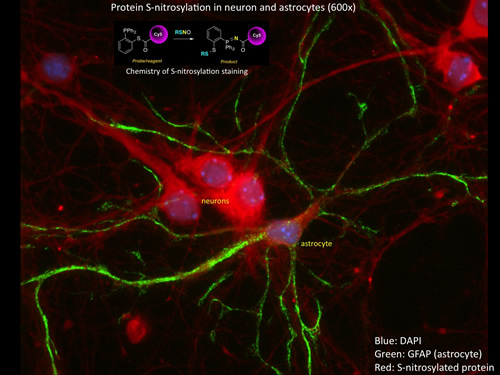
|
 |

Research
Nitric Oxide:
Chemistry and Pathophysiology

Our laboratory has been interested for many years in the
formation, distribution, and metabolism of nitrate, nitrite,
and N-nitroso compounds. This work led to our discovery of
the endogenous synthesis of nitrogen oxides and eventually
the discovery of nitric oxide as a biological molecule. At
present our laboratory is conducting research on the pathophysiological
consequences of nitric oxide and its oxidation products.
This encompasses cell-mediated nitrosation, free-radical
reactions, and oxidation. We are particularly interested
in the nature of chemical damage to DNA and its genotoxic
consequences. From a health point of view this is important
for the inflammatory state and for various infections and
diseases that increase the risk of cancer. We are also interested
in the inhibition of these reactions by antioxidants and
other substances that offer protection from oxidative stress.
To further explore this research, click
here.
Inflammation: The Cancer Connection (pdf)
Tissue
Engineering for Drug Development and Chemical Toxicity
Cells placed in culture generally lose at least some key differentiated
physiological functions that they normally exhibit as part of organized tissues
in the body. Thus, while cultured cells may be adequate for some applications
in drug metabolism and detection of toxins, they are certain to fail for others.
We have developed an in vitro organized tissue-based sensor for detection of
unknown toxins and rapid screening of drug metabolism. The technology combines
a unique chip-based micro tissue arrangement with mass spectrometric and optical
sensors to detect changes in tissue behavior and measure primary and secondary
biochemical transformations of drugs and toxins.
Quantitative
Ultramicro Measurements for Drug and Carcinogen Metabolism
We are developing new approaches to measure the fate of drugs and chemicals
in the classical paradigm for drug metabolism: Absorption, Distribution, Metabolism,
Excretion (ADME). The methods include variations in biological Mass Spectrometry
and Laser-Induced Fluorescence Spectroscopy. An important new, unique tool
is an Accelerator Mass Spectrometer for C14 and tritium that will be directly
coupled to gas and liquid chromatography. These tools will enable us to conduct "Nanotracing" of
molecules in humans at heretofore unexplored levels.
top
|
 |
